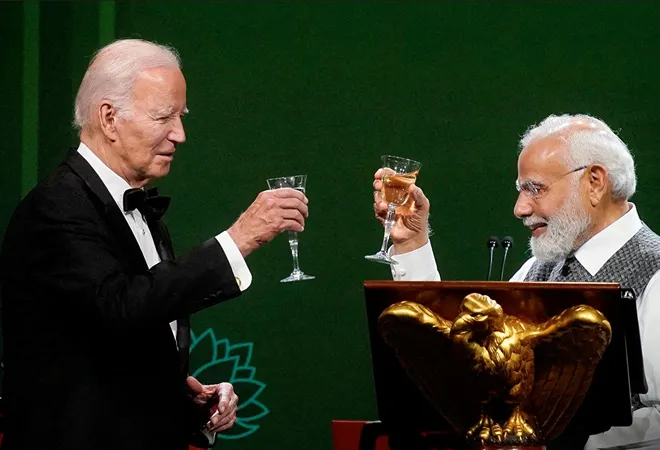-
CENTRES
Progammes & Centres
Location

All high-level foreign policy engagements are curated and carry with them a dose of theatre but as the dust settles, some become part of history and others are consigned to the dustbins of history.It has been a long and winding road indeed for India and the US, as well as for Modi himself. For a leader who was shunned by the US for years, it has been a momentous journey of crafting a robust new trajectory for India-US bilateral ties. For many who had assumed that the civil nuclear pact was the high water mark of bilateral engagement, Modi's push for seeking greater synergy between New Delhi and Washington by burying shibboleths of the past has been a revelation. His leadership has been critical in ensuring that long pending foundational agreements were finalized and new vistas were identified in technology and defence. Working with three US Presidents of very different temperaments over the last nine years, Modi was able to forge a personal bond with each one, keeping the focus securely on the wider strategic convergence. In this, he was helped by structural realities that have evolved rapidly over the last decade. China's rise and President Xi Jinping's aggressive posturing across the Indo-Pacific and in the Himalayas made continuing India-US engagement in the region and beyond a veritable necessity. An India that was hesitant to join the Quadrilateral Security arrangement in 2007 had no compunction in galvanizing support for the same platform a decade later. With the Galwan episode of 2020, a new strategic clarity emerged in New Delhi that has shaped the trajectory of Indian foreign policy in directions few would have envisioned just a few years back. When Joe Biden came to power, there were many in India who raised the possibility that his administration might be tough with India on issues of democracy and would want to focus on domestic political issues. There were similar apprehensions when Donald Trump assumed American Presidency with concerns about him being difficult to deal with on economic matters. But all those concerns were unfounded when it came to the actual engagements between India and the US in the two administrations. The bilateral relationship has continued to grow and has in fact matured, with not only the top-level leadership but also the bureaucracies in the two nations becoming increasingly aligned. This has not meant that there have been no differences. In fact, the relationship has continued to grow despite differences. The two nations have had different approaches to the Ukraine war with New Delhi reluctant to publicly condemn Russian aggression and continuing to buy Russian oil. Yet Washington has been sensitive to Indian concerns and there has been a growing understanding of Indian constraints when it comes to Russia. The Modi-Biden joint statement "called for respect for international law, principles of the UN charter, and territorial integrity and sovereignty" while expressing concern over the conflict in Ukraine.
The bilateral relationship has continued to grow and has in fact matured, with not only the top-level leadership but also the bureaucracies in the two nations becoming increasingly aligned.During Modi's visit, the two nations charted an ambitious agenda covering a diverse range ning semiconductors, critical minerals, technology, space cooperation and defense manufacturing and sales. The ease of their bilateral engagement today underscores their joint commitment to keep the big picture in focus and not allow tactical differences to derail the wide-ranging consensus. For the US, it has taken some time to comprehend that as a non treaty alliance partner, dealing with India will require a different set of rules and expectations. For India, it has been a learning curve to ensure that New Delhi is not only critiquing the existing global order but is also a full participant in providing solutions for the management of global disorder. India's economic rise in the context of a political order that remains quintessentially pluralistic and democratic, despite challenges, is a testament to its resilience. It is this resilience that the US celebrated during Modi's state visit last week. Today, the US needs a democratic, economically buoyant India to craft a stable regional order in the Indo-Pacific. And India too requires a solid partnership with the US if it is to fulfill its domestic developmental needs as well as manage its external challenges effectively. Modi's real contribution lies in recognising this fundamental reality and working toward operationalising it over the last nine years. Whether Modi's visit will be as consequential as Deng Xiaoping's US visit in 1979 would be determined by how sagaciously Modi and his successors are able to exploit this outcome to India's advantage in the coming years.
The views expressed above belong to the author(s). ORF research and analyses now available on Telegram! Click here to access our curated content — blogs, longforms and interviews.

Professor Harsh V. Pant is Vice President – Studies and Foreign Policy at Observer Research Foundation, New Delhi. He is a Professor of International Relations ...
Read More +